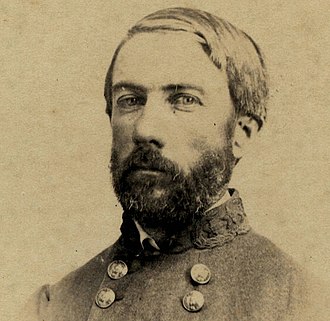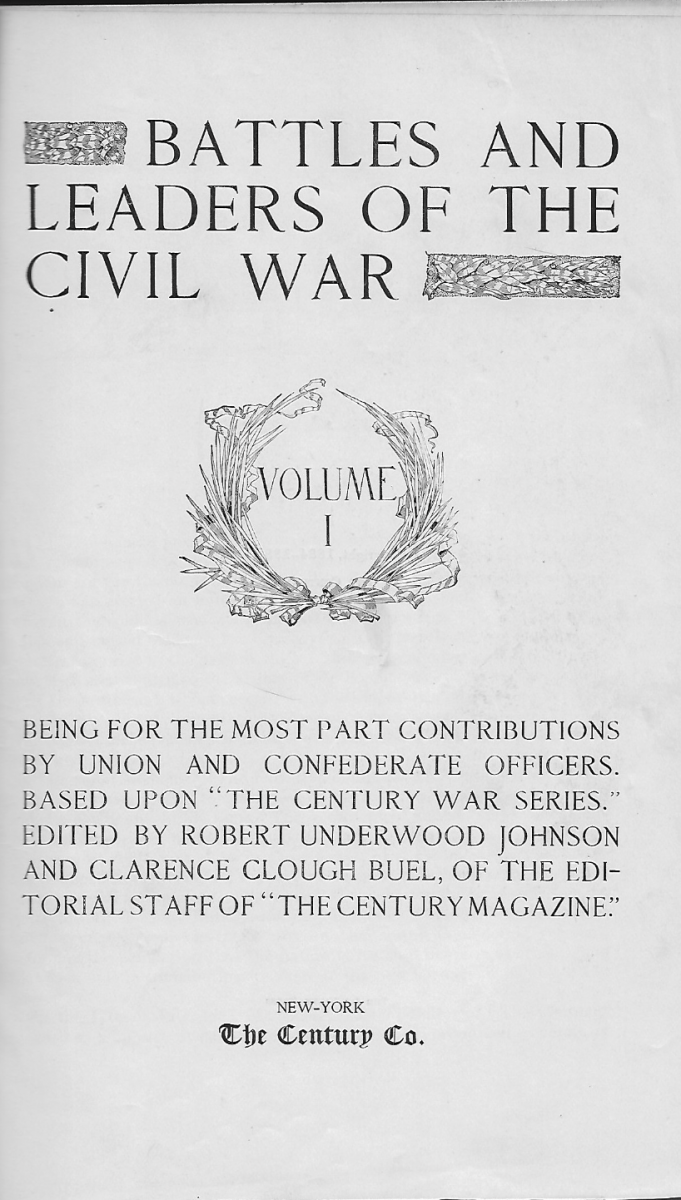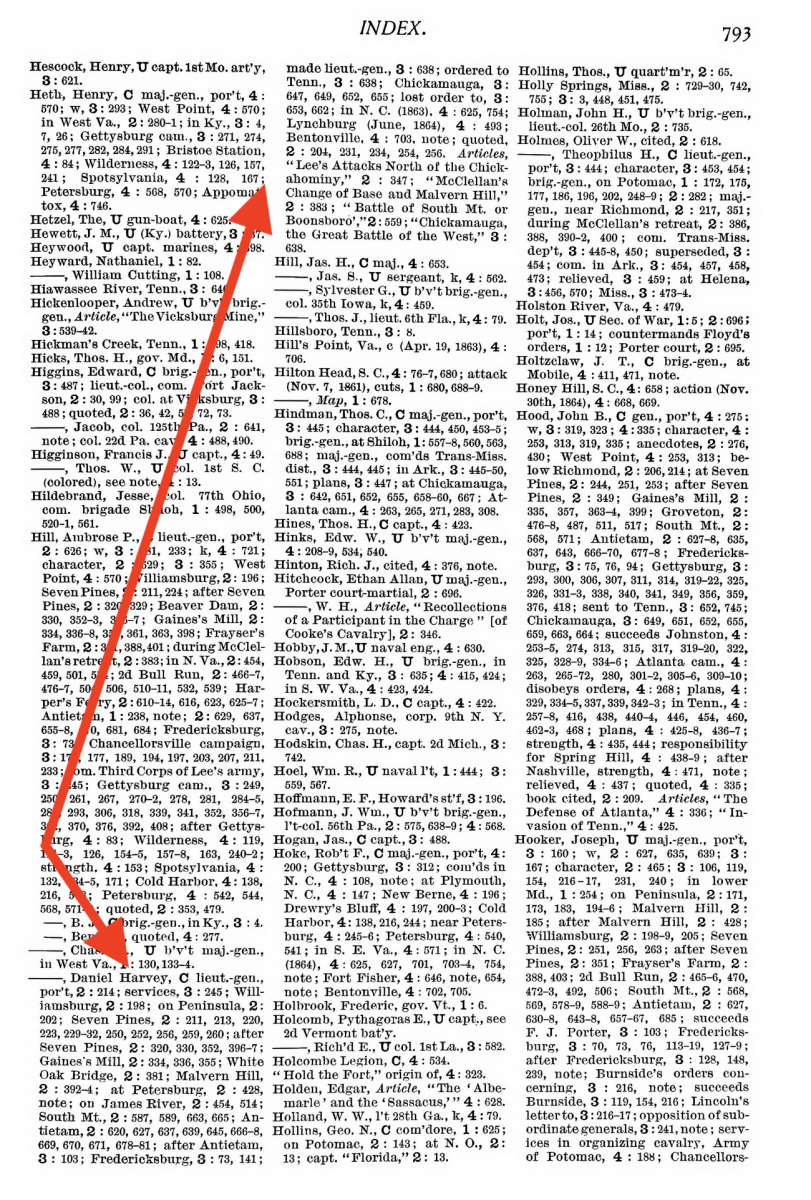- About MAA
- Membership
- MAA Publications
- Periodicals
- Blogs
- MAA Book Series
- MAA Press (an imprint of the AMS)
- MAA Notes
- MAA Reviews
- Mathematical Communication
- Information for Libraries
- Author Resources
- Advertise with MAA
- Meetings
- Competitions
- Programs
- Communities
- MAA Sections
- SIGMAA
- MAA Connect
- Students
- MAA Awards
- Awards Booklets
- Writing Awards
- Teaching Awards
- Service Awards
- Research Awards
- Lecture Awards
- Putnam Competition Individual and Team Winners
- D. E. Shaw Group AMC 8 Awards & Certificates
- Maryam Mirzakhani AMC 10 A Awards & Certificates
- Two Sigma AMC 10 B Awards & Certificates
- Jane Street AMC 12 A Awards & Certificates
- Akamai AMC 12 B Awards & Certificates
- High School Teachers
- News
You are here
Building a Book: HathiTrust, Ancestry.com, Serendipity, and Lifetime Interests – Daniel Harvey Hill (1821–1889)
The first idea that popped into my head for a vignette concerned Daniel Harvey Hill (1821–1889) and his algebra textbook of 1857. I first became aware of this book in the 1990s, while I was working on a doctorate in the history of science at Johns Hopkins University. During one summer of this period, I had a fellowship at the Smithsonian’s National Museum of American History, supervised by Peggy Aldrich Kidwell. Peggy introduced me to a number of historians of mathematics, one being the late Uta Merzbach. When Uta learned that my dissertation was leading me to delve into 19th-century American mathematics textbooks she alerted me to the fact that a prime resource for such books was the Artemas Martin Collection at nearby American University (AU). Florrie Fasanelli, another math historian, who had received her doctorate at AU, on hearing that I was planning to visit the Martin Collection, suggested I check out the “slavery problems” in Elements of Algebra, by D. H. Hill [Hill 1857].
I do not believe that I had to make a special appointment to look at books in the Artemas Martin Collection, but as with most “special collection” holdings in research libraries, I could not simply browse the stacks for these books, nor could I, or anyone, check them out to take home. To look at Hill’s book, and the other books I was seeking that day, I had to first find their call numbers, which at the AU Library in 1996 meant searching the card catalog, either by title or author. I filled out and submitted a handwritten request form, proceeded to a special reading room, and then waited until the archivist wheeled out my requested volumes on a cart. I was not required, as I recall, to wear special gloves, but I was certainly admonished to take particular care of the fragile 19th-century books with which I was presented. Within Hill’s book, my perusal did indeed reveal several problems referring to the infamous social institution still widely prevalent at the time of the book’s publication. The casual way in which Hill offered these problems convinced me, more than any other evidence before or since, of the thoroughness with which slavery was entwined in the life of the nation and of the consequent difficulty of uprooting it. For example, Figure 2 shows a problem designed to test a student’s skill in setting up and solving quadratic equations.

Figure 2. Excerpt from D. H. Hill, Elements of Algebra [Hill 1857, 321].
I am positive that I requested permission to make photocopies from several of the books I examined that day, including Hill’s. However, I no longer remember whether I was able to make these copies myself or whether this was done by someone from the library staff. Nor do I recall whether I had to pay for these copies; policies on these matters varied greatly from library to library. Younger readers take note: it would be more than fifteen years after this 1996 library visit before I possessed a portable device capable of taking a useful picture of the pages of a book.

Figure 3. Portrait of Gen. D. H. Hill, 1861–1865, University of South Carolina Libraries. Public Domain.
I would make brief reference to Hill’s book in my dissertation of 1998, not with regard to slavery but as an example of how algebra textbooks of that era made no appeal to the geometric representation of numbers on a “number line.” But the existence of Hill’s slavery problems stayed with me, partly, I’m sure, because Hill had already been known to me for over thirty years. I had been a Civil War buff when I was a kid in the early 1960s, when there had been considerable publicity about centennial anniversaries of events related to that war—for instance, I recall in 1961 standing with my parents in a crowd on the east side of the Capitol to see a re-enactment of Lincoln’s inaugural of 1861. I had eagerly lapped up all sorts of information about the war. Thus I had been well aware since then that D. H. Hill had been a general in the Confederate army. Nor did I confuse him with another Confederate general, the more famous A. P. Hill (1825–1865).
And so, Hill and his textbook immediately came to mind in 2014 as a way to connect mathematics with American history. I came up with nineteen other candidate mathematical “events” to cover 200 years of American history and wrote up an outline. Vince Burke tentatively approved this scheme, and when he asked for a sample chapter, in the summer of 2015, I chose the chapter on Hill. But 20 years after that visit to the American University Library, I no longer needed to leave my house to look at his 1857 textbook. It was readily available online, for free. For example, one source was the HathiTrust Digital Library. In fact, HathiTrust had two distinct copies, one from Harvard and one from the University of California at Berkeley. Diligent souls at these two institutions had carefully scanned every page of the physical texts in their libraries and made these scans available, so that researchers such as myself could pore over these volumes without actually touching them. And such is now the case for vast collections of out-of-copyright material from the nation’s research libraries. (Every so often one glimpses a part of someone’s finger on these pages, a reminder of the physical labor involved.) Moreover, not only can these books be read remotely, they are in many cases fully searchable, a magically delightful feature for researchers brought up in earlier eras. In the case of Hill’s Elements of Algebra, I no longer had to hunt through the book page by page to find those disturbing problems. I could merely type “slave” or “negro” into the search feature of HathiTrust.
The sample chapter I wrote on Hill was focused on his textbook. But Vince found the chapter “too stiff and formal.” He urged me to find a better way to draw the reader in. I combed through additional sources on Hill. For example, I found that HathiTrust had not only Elements of Algebra but also Hill’s 1858 book, A Consideration of the Sermon on the Mount [Hill 1858]. This had some fascinating revelations of Hill’s personality: the anguish he felt at the death of his six-year-old son; the contortions he exhibited in using his Christian faith to defend slavery against abolitionists. Would I, in pre-internet days, have taken the trouble to find a physical copy of this book in a library? Very doubtful. In the end, I did not cite this book in my chapter on Hill, but I think it subtly influenced my portrait of him.
The source that ultimately gave me the opening scene of the chapter turned out to be physical after all: the celebrated Battles and Leaders of the Civil War, published in its entirety in 1887, in four massive volumes totaling over 3,000 pages. True, by 2015 I could have found Battles and Leaders online, but I just happened to have a physical copy. These volumes, passed down to me, had been a treasured possession of my paternal grandfather, a high school history teacher, one of whose own grandfathers had been a veteran of the Union army. Of course, this Battles and Leaders was not digitally searchable, but the excellent index proved adequate for my purposes.


Figure 4. Pages from Battles and Leaders of the Civil War, owned by David Lindsay Roberts.
The page on the bottom, from the index, shows entries on D. H. Hill at the bottom of the left column
and the top of the middle column. Photos by David Lindsay Roberts.
Hill was among the military officers, from North and South, who had been solicited by The Century Magazine to contribute to this work. I used his account of his experiences at the Battle of South Mountain, just prior to the blood bath at Antietam, to craft a dramatic opening to the chapter [Johnson and Buel 1884, 2: 562]. This incident had nothing specifically to do with mathematics, but Vince loved it as a chapter opening, and approved my subsequent decision to tell Hill’s entire life story, rather than confining myself to a single decade. The algebra book was still discussed but was less central.
At that point, I found myself revising my idea for the structure of the “vignettes.” Rather than narrowly focusing on a decade, I started conceiving of them as short biographies, ranging backwards and forwards in time to cover the entire life of the person involved with the initial “incident.”
David Lindsay Roberts (Prince George’s Community College), "Building a Book: HathiTrust, Ancestry.com, Serendipity, and Lifetime Interests – Daniel Harvey Hill (1821–1889)," Convergence (January 2022)




